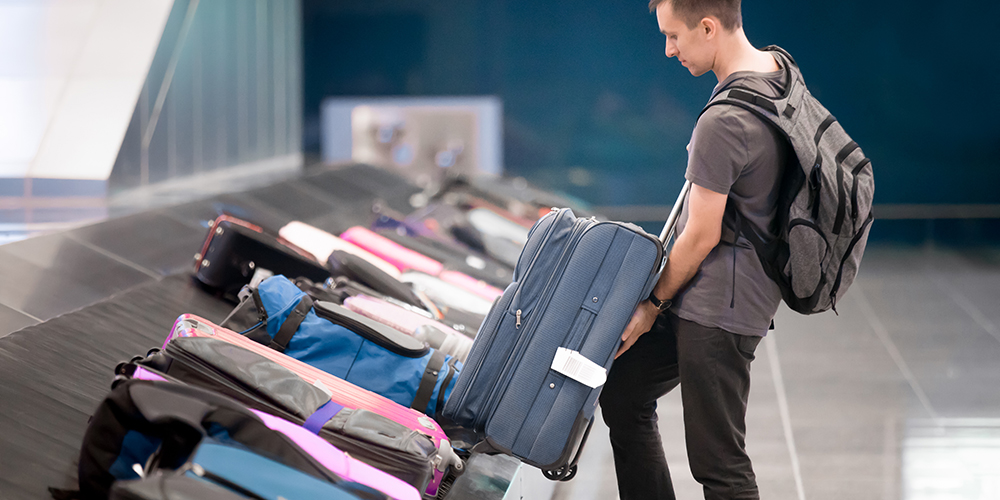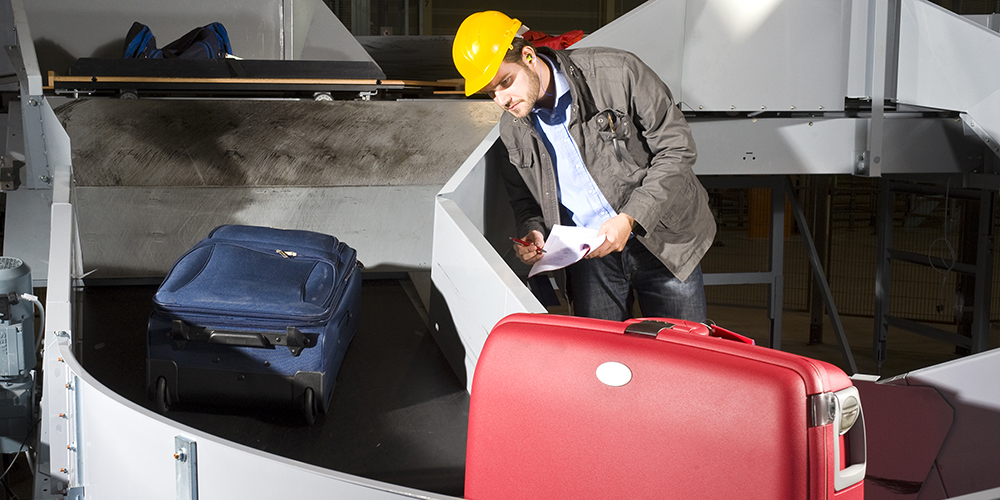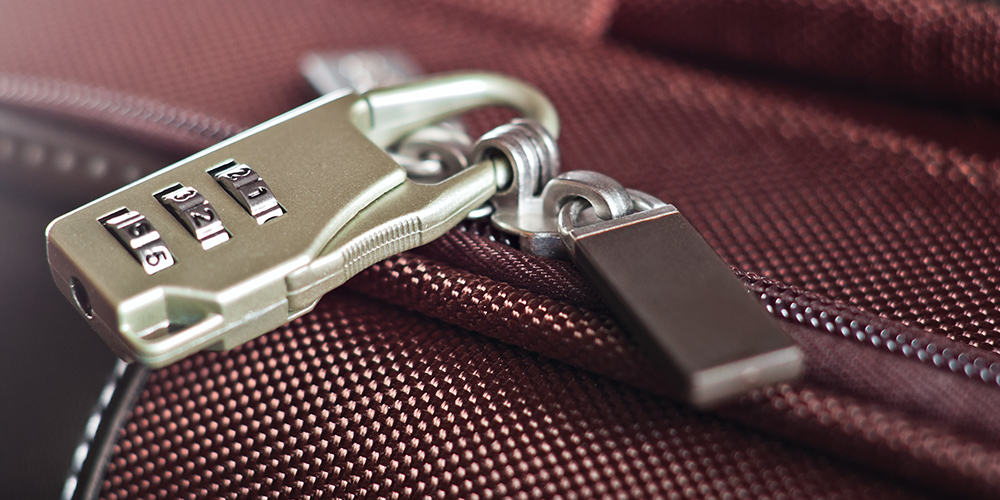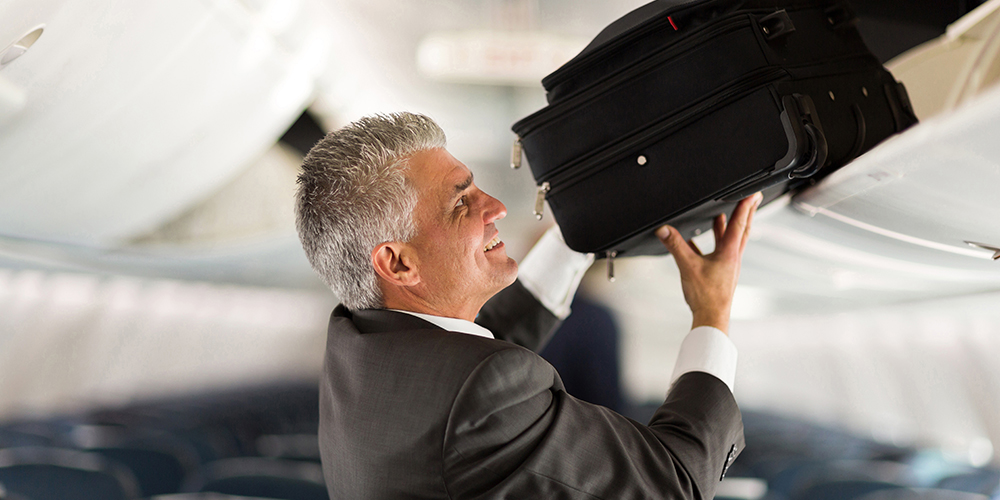Lock Blog
A resource for consumers, locksmiths, and security professionals
A resource for consumers, locksmiths, and security professionals

Why do you need to care about securing checked luggage? Baggage handlers have so much time with the luggage when you are not around to supervise it, and the nature of the item relies on its ability to open smoothly as well as be light enough to transport. Theoretically, this should not be an issue because these employees should not be criminals. But we do not live in an ideal world. Wide scale corruption plagues this field, with no end in site. Much like a bike security, most people throw their hands up and declare suitcases beyond protection. And unlike home security, your answer cannot be that you are going to shoot the person trying to steal from you. The airport limits you from all kinds of options. Government agency oversight also gives third parties the authority to legally undermine your security. So how do you protect from the people that are trying to steal from you and not incur the wrath of the TSA?
It is a myth that you can only use the TSA approved padlocks to lock your suitcase. You can most certainly use your own locks to keep your baggage secure. When you check your luggage, the TSA agent can request to open it if there is any concern. You will have to provide the agent with the proper keys. After they have found that there is no threat, the bag can continue toward the plane. If the case is flagged later in the process, then the TSA will have to break your lock (assuming you have provided yourself with the proper security). Once your lock is broken, and the suitcase was been screened, it will be closed and no new lock will be added. The bag will reach its destination without any of the travel security that you have invested in, and it will be as if you had never bothered to use any locks. The exact quote from the TSA’s official government blog (it is a real thing) is that the “TSA is careful to not damage any personal belongings, however, we are not liable for damage caused to locked bags that must be opened for security purposes.”
This should have said, “TSA is careful to not damage any personal belongings” full stop. The “however”, in this case, acts as a negation of the previous phrase. Even if you have the TSA approved locks their website says that this is only, “reducing the likelihood of damaging the lock or bag if a physical inspection is required.” The comments section of the blog has several stories of people having their TSA approved locks broken open or simply not being reattached. The fact of the matter is that the TSA is going to do what they are going to do. You will never be able to stop a person from getting into your bag because in some cases they will be sanctioned by the government to do so. There are no perfect locks, and surely no perfect security. Buying time won’t even get you much if your locks have been removed by agents that are allowed to take as much time as they need. The only thing you have control over is what type you will use.
Do you want something that is going to alert you if a person takes something or something that will stop someone from taking something in the event that the lock is not removed? The answer to that comes down to yet another question. Do you believe that the TSA will find cause to open your bag? Regardless of whether or not you think you are going to be robbed, you should have security. That security is going to deter crime even if it can’t stop all of it. So if you do think the TSA will open your bag, having good security will lead to you having no security. Having alert measures will tell you if your bag was opened, or molested, in a thievery attempt. But it will do little to protect from a criminal. Best case scenario is that the crook will see the device and recognize that the seal will break when he tries to open or close the lock. The more realistic scenario is that they will realize their mistake after it is too late. In that case, they have little to gain from returning the property they have stolen.

Theft – Items left in checked luggage are stolen by the baggage handlers. This problem has been widely documented, and now citizens worldwide are trying to protect their property from the same people that are supposed to be protecting them from terrorism. For the most part, these employees are not monitored or screened past the time of their hiring.
Added Items – Although it is uncommon, it does happen. The most common items placed in a bag are drugs. This problem is seen most often during international travel. The perceived threat of global terrorism also creates the fear that a bomb might be added to your luggage. This crime is also perpetrated by the baggage handlers. Due to a lack of screening on the back end of the airport, these employees can bring the items into the airport. All that is left is to plant them, and if done correctly, remove them before they are discovered. When they are unable to remove these illegal, or illegally transported, items the person in possession of them is the unsuspecting owner of the suitcase.
Lack of Security – People are overwhelmed by the idea of securing their luggage. TSA locks have not only been shown to be easily pickable, but the master keys are now available on the internet. That means that any thief can buy a key rather than learn to pick your lock. And picking, in this case, is almost too kind a word. In some cases just poking around the lock with a piece of metal will open it. On top of that, a suitcase is not a very secure item. It is made to be easily transportable. Some people might just take the case. And the weight restrictions keep the materials rather light, which makes most cases flimsy. That way the case can be broken even if the lock can’t. Include a zipper in the mix, and now security seems impossible.
Destroyed Security – You may be allowed to use your own locks, but the TSA still wants to have the ability to screen your luggage. If they decide to do that after you have initially opened the bag, then they are going to break your locks open. Their blog says, “if you decide to lock your checked baggage and TSA cannot open it through other means, then the locks may have to be cut.” Once a lock is opened this way it no longer provides security. It will alert you upon getting your luggage (or upon getting arrested) that your property has been tampered with. Between your security being compromised, and receiving your luggage after you have arrived, a lot of people are going to see that bag. You added security, but when you needed it, it was gone.
Before we talk about the locks and other measures you can take to secure your luggage, we need to talk about the luggage in general. If you have a basic suitcase with a fabric body and a zipper system, then a lock is not going to do much for you. The bag can be slashed open if the person does not care about the theft’s discovery, but more commonly, the zipper can be punctured. By placing a ballpoint pen at the seam of the zipper track and pushing into the bag, you can make an opening. With that opening, the pen can be run along the length of the zipper until the bag is wide open. Once the theft is complete, the zip pullers can be pulled over the track, (while locked) and re-seal the bag. There will be no visible sign of entry.
This is a trick that is widely known throughout the airport security industry. The TSA use the pen method of entry during their baggage inspections. Instead of removing your zip ties and/or cutting your non-TSA approved lock, the agent will simply ignore the security. You might have even found a “Notice Of Baggage Inspection” slip inside your seemingly unbreached suitcase. Keeping your security devices intact and on the luggage is not malicious in this case. The idea is that breaking your locks and zip ties will make you more susceptible to criminal activity. The downside to this practice is that it educates the very people you are trying to protect yourself from, on ways to covertly access your property.
Invest in a hard-sided suitcase. The difference is not only in the lack of fabric but also in the hasp system. Instead of a zipper, there will be at least two hasps for you to place your high-security locks on. The hard case with hasps will be completely foolproof against pen puncture attacks. Make sure to take into account your shackle length, because if the shackle is too long the case might open enough to remove its contents. When you are buying this type of suitcase it would be ideal to see the product before you buy it. Make sure the material is rather solid and will not be easily broken. And check to see that the lid forms a tight seal when closed. One of the advantages of a hard body case is how tight that seal is without the zipper. If that connection is loose or has a gap, it will weaken the security of the container.
Something like the cases made by Pacsafe will provide similar security. Cases like this still have a zipper and fabric body, but they adjust for security concerns. The zipper uses ToughZip technology and is puncture resistant (not proof). I am also weary of products that say resistant. The term ‘resistant’ is similar to a ‘however’. It means it should work, but if it doesn’t…well it didn’t say puncture proof. There is also a high tensile stainless steel wire mesh that lines the bag to protect from slashing attacks. The downside to this more discreet protection is that someone might attempt these methods and harm your bag. On the other hand, the hard-sided case may deter the criminal from even trying to open it. A hard case can still be broken, but it will be more obvious and harder to do to the degree where items can be removed or inserted from the bag. Pelican cases are a good example of a product with this type of protection. With either of these product types, if you get the correct locks you should be safe from most criminals.

The locks need to fit the case. Whatever they will be fastened to, they need to close the case so there is no gap. If there is a gap someone can still open the case, may be enough to place something inside or take something out. Conversely, if the shackle is too small, then it will not be able to secure back into the lock body. When you are buying the lock you must also check the thickness of the shackle. If you are still using the holes in the sliders of the zipper, your shackle will need to be very thin. The thinner the shackle, the easier it will be to cut.
TSA – I cannot recommend these locks in good consciousness. The skeleton key schematics have been put on the internet for anyone to make, but the locks provided very little protection before that. The shackles on all of the locks are very thin and could be cut with a pair of good pliers. These locks can be raked or picked open, and some can be opened by just shoving a tension wrench into the lock and poking around. Most baggage handlers can bring these tools into work unchecked, and with the amount of bags they see daily, they can get quite a bit of practice. If you care at all about keeping your checked baggage safe, I would advise against using any of the TSA approved locks.
High Security – Padlocks on all the hasps of a hard-sided case is a good place to start. When buying your padlocks do not cheap out on the protection. Do a little research and find a solidly constructed lock that will protect against multiple types of attacks. Because of how unsupervised some of the baggage handlers are I would recommend trying to get something with a higher pick resistance. I usually don’t warn the general public about this, because most criminals don’t pick locks, but this is a special case. These people will have time and a lot of exposure to overcoming padlocks. The baggage theft rings go undiscovered for a while, which will also give these criminals some time to hone their so-called craft. Research to make sure the locks you are looking to buy do not have widely publicized weaknesses or bypasses. That means getting something with ball bearings that make it impossible to shim.
Other high – Security features other than ball bearings are anti-drill plates, hardened steel pins, more pins, security pins, shrouded shackles, thicker shackles, etc. The anti-drill plates and hardened steel pins are meant to stop power drills. The plate will spin with the drill bit to try and keep the drill from biting into the metal. The steel pins will hopefully be harder than the drill bit itself, and keep the lock from being fully compromised.
More pins and security pins will help with the pick resistance. More pins just create a headache for the picker. Anything more than five is above average. Security pins are going to give the picker a false set. That means that they will think that they have successfully picked the lock, but really the pins are just caught on the shear line. The best type of security pins (ones that most pickers struggle with) are serrated pins.
Shrouded shackles and thicker shackles will make it harder for the criminal to cut the padlock off. A shroud (also known as a shield) will be a piece of metal connected to the body of the lock that adds an additional thickness to a section of the shackle to give less space to apply bold cutters. A thicker shackle works in a similar way, but it is simply the shackle that is stronger.
I will mention some brands that you can look into. The rule of thumb, for locks, is that you are going to get what you pay for. Even if it is $7 more it will probably come with better security. If you start around the $25 dollar range for any of these brands you should be getting quality high-security. Abus (excluding the ZB aka 180ib, which is an example of an ineffective lock), Mul-T-Lock, Best, and Medeco are good jumping off points. Chances are you will need at least two padlocks for your hasp system.
It is always better to have two dissimilar locks. This variation should protect against a criminal that relies on only one method of entry. Also, an industrious criminal that finds a way to open one of the locks cannot then use that same method to open the second lock. Customizing the lock will also give you additional protection. If you get a product with a replaceable core you can always upgrade as needed. If you are buying second hand, make sure that the lock includes a key. Ebay locks might be geared towards locksporters and collectors who do not mind making a new key.

There is a very simple way of keeping your valuables safe: Don’t put expensive or valuable items in your checked luggage. Put anything you care about keeping in your carry on. Keeping a line of site with your case gives you a tremendous boost in security. Of course, this is simply not possible in every situation. If you are transporting firearms and/or ammunition then you will need to put that in your checked luggage. Other restrictions might also force you to place items you care about in your checked suitcase. So for added security, try to get a little creative. These methods are meant to be used in addition to your base level of security.
Saran wrap, non-standard tape seals, tamper-evident locks, and the like fall somewhere between your average TSA lock and a high-security lock. They are not very resistant to security breaches, but they should indicate that the bag has been opened. A cut in the saran wrap can be covered by more saran wrap. But it seems to deter some baggage handlers from trying to open them. A non-standard tape seal will not prevent the bag from being tampered with, but you can reject responsibility for the contents if you see that it has been broken. There is also a very limited amount of time to report baggage theft or tampering.
Ideally, you want to know about the problem and inform the proper authorities before leaving the airport. Some locks can act in a similar way, such as the Cliplok padlock. This device can be cut at a certain point and still be relocked. This lock provides very little security, but it can continue to give you that low level of security even if the TSA opens it. The only advantages are that there is not a TSA master key and you can tell if the lock has been opened.
Things like zip ties might also inform you if the case has been opened. Make sure that they are not standard zips, because these are sometimes carried by the baggage handlers. Unique zip ties will show the criminal that their replacements will raise red flags. Anything that is out of the ordinary will deter most thieves from their routine. Because you cannot have amazing security on an item like this, you just have to have unique security and better security than the bag on either side of you. Similar to the old adage of the two friends being chased by a bear, you don’t have to be better than the criminal, you just need to be the least appealing target.
Whether you love to travel or do it because you have to, you are going to want your property to be safe. It is an uphill battle. And that hill only gets steeper when you have to fly. There are rules that you are required to follow, even if you do not agree with them. Policies at the airports are going to make your belongings more vulnerable when they are separated from you. The best you can do is make the decisions that you think best fit your situation. Use your own discretion. Find out what your greatest concerns are, and match them with a security plan that addresses those issues.
Take into account your case and your locks. Find the weakest link in the chain and strengthen it. Just because it is difficult, it does not mean it is impossible. I will never stop stressing the importance of layered security. Add multiple levels to your protection. Locks, a hard-sided case, a tamper evident seal, all covered in saran wrap is going to be passed over by just about every thief that sees it. But if the TSA strips off all that security, you become a potential victim. What can you do? You can’t always take the train.
Category: How To's, Safety & Security, Travel Security